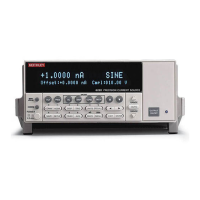Model 6220/6221 Reference Manual Remote Operations 10-17
Return to Section 10 topics
Using common commands and SCPI commands in the same
message
Both common commands and SCPI commands can be used in the same mes-
sage as long as they are separated by semicolons (;). A common command can
be executed at any command level and will not affect the path pointer.
:stat:oper:enab <NRf>; *ESE <NRf>
Program Message Terminator (PMT)
Each program message must be terminated with an LF (line feed), EOI (end or
identify), or an LF+EOI. The interface will hang if your computer does not provide
this termination. The following example shows how a program message must be
terminated:
:sour:swe:poin 10 <PMT>
Command execution rules
• Commands execute in the order they are presented in the program
message.
• An invalid command generates an error and is not executed.
• Valid commands that precede an invalid command in a multiple command
program message are executed.
• Valid commands that follow an invalid command in a multiple command
program message are ignored.
• For fastest command execution:
1. Do not use optional command words.
2. Do not use the colon (:) at the beginning of a program message.
3. Always use the short-form versions of commands and parameters.
4. Minimize the amount of “white” space in command strings.
5. Keep numeric parameters simple (i.e., 1 vs. 1.000e + 00).
6. Use all uppercase.
Response messages
A response message is the message sent by the instrument to the computer in
response to a query command program message.
Sending a response message
After sending a query command, the response message is placed in the output
queue. The response message is sent from the output queue to the computer.
Test Equipment Depot - 800.517.8431 - 99 Washington Street Melrose, MA 02176 - TestEquipmentDepot.com

